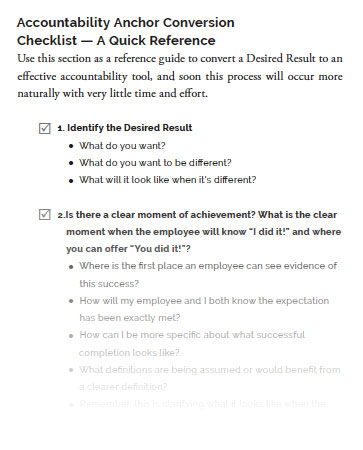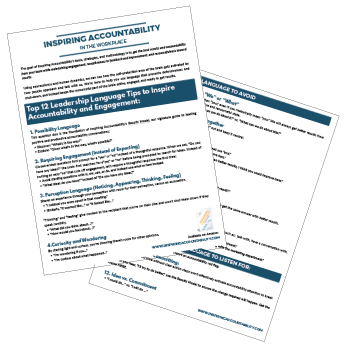What Does Accountability Mean: Ownership

What Does Accountability Mean in the Workplace?
PART 3: OWNERSHIP
This is part three of a blog series on “What Does Accountability Mean in the Workplace?” Previously, you learned productive alternatives to “Taking Responsibility” and demanding “Compliance.” As the final part of this blog series, we’re exploring how to transform wanting employees to take more ownership into getting the specific result you really want.
Prefer to listen to this blog? You can here!
–
One of accountability’s popular synonyms is “ownership,” as in, “I need my employees to take more ownership.” You may want employees to “own” outcomes; however, asking employees to take greater “ownership” without greater specificity can be destructive.
Outside of employee-owned companies, employees are not owners or executives. Employees don’t have as much at stake. Their lower compensation indicates their lesser impact and “ownership.”
It’s unhelpful and frustrating to expect employees to care and sacrifice as much as those higher on the ownership ladder. It can create confusion, discouragement, and resentment to insist on cultivating a feeling of “ownership” when employees are rarely empowered enough to take initiative and make decisions without being overridden or undermined by higher-ups.
“Everyone can’t be owners unless everyone’s empowerment is equal.”
Even if an employee does “take ownership,” you might find that translates to having a difficult or obstinate employee. Do you know an employee that acts like they’re the owner, makes decisions without consulting management, and takes great pride and responsibility in their work?
These employees get resentful if the decisions they “owned” aren’t upheld. They get frustrated and discouraged if their work, of which they took ownership, wasn’t actually what management wanted and gets disregarded or criticized.
Everyone can’t be owners unless everyone’s empowerment is equal.
Inspiring Accountability Solution to Ownership
When I hear leaders say they want employees to take more ownership, it is a red flag that:
- The leader is not productively holding the employee accountable (which would address symptoms like poor engagement or follow-through), or
- Employees do not have a sense that they are empowered (which would address symptoms like poor initiative, decisiveness, or action).
Just like accountability, a lack of ownership often indicates a lack of empowerment. In my experience as a leadership consultant, the amount of empowerment needed is often not supported within the structure of office hierarchy.
So, if the amount of empowerment needed is unrealistic or unavailable, then “ownership” is not the problem or the solution. There is a specific desired behavior that can serve as a more productive way to describe the issue.
Requesting more ownership is not a clear enough request to inform the employee what to do differently.
“If the amount of empowerment needed is unrealistic or unavailable, then ‘ownership’ is not the problem or the solution. There is a specific desired behavior that can serve as a more productive way to describe the issue.”
How to Provide Clear Expectations:
Start by clarifying the specific change you want to see. Change the generalized word “ownership” to an actionable Accountability Anchor, a clearly defined Desired Result that an employee works toward and by which a leader calibrates the employee’s success.
With an Accountability Anchor, a leader can effectively “anchor” the employee to a clear expectation, closing the distance between the actual result and Desired Result.
You can create an actionable expectation by filtering your Desired Result through the Accountability Anchor checklist. There is an entire chapter in Inspiring Accountability in the Workplace dedicated to creating clear expectations, and here is the distilled, high-level overview:
- Identify the Desired Result
- Is there a clear moment of achievement?
- Is it achievable within three months or less?
- Is it stated as what you want (not as stopping what you don’t want)?
- What are the Actionably Clear Expectations and Specifications?
- What is the contribution context?
- Is it confirmed in writing?
You can use these questions to replace a desire for ownership with clear expectations that will help you more efficiently and effectively get the results you need.

Subscribe and get immediate access to the full version of the Accountability Anchor Conversion Checklist, including expanded prompting questions:
Ownership Conclusion
There are many synonyms for accountability referenced in the workplace, and now you can shift your vocabulary and approach to inspire accountability and productively get better performance from your team.
Next time you’re tempted to think of your accountability challenges as taking responsibility, compliance, or ownership, come back to this article series for more effective approaches to getting the results you really want.
For the full set of Inspiring Accountability Resources, pick up your copy of Inspiring Accountability in the Workplace, available as a paperback, eBook, and audiobook on Amazon.
What do you think? Share your questions or experience in the comment section below!
Want new articles before they get published?
Subscribe!


